Do you have a majestic Black Great Dane?
These dogs are often called “the black beauties” for their sleek, all-black coats.
Black Great Danes are gorgeous, and there is much to love about these dogs, from their gentle dispositions to their impressive size.
The standard colors of Great Danes include:
- Black (Black Great Danes)
- Mantle (Mantle Great Danes)
- Harlequin (Harlequin Great Danes)
- Merle
- Fawn (FAWN GREAT DANES)
- Brindle (BRINDLE GREAT DANES)
- Blue (Blue Great Danes)
Off standard colors include Double Merle Great Danes, which are White Great Danes that often have predisposed health conditions. Off standard colors that are not approved to be in the show ring are typically bred without health testing. (OFF STANDARD GREAT DANES)
Read more about the colors of Great Danes here.
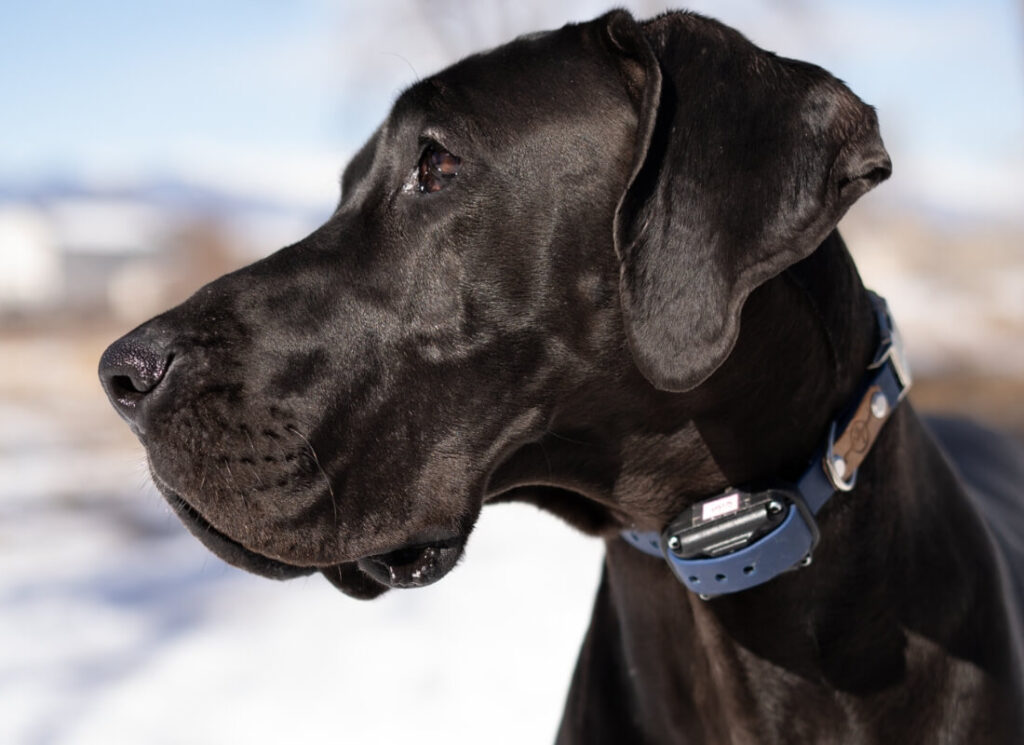
Black Great Dane History
The Black Great Dane is a German breed of dog that is also known as the Dog Grand Danois. Black Great Danes have a long and proud history.
The breed was first developed in the early 19th century, and it quickly became popular among German nobles. Originally bred as boar hounds to hunt wild boar, they quickly became beloved by German breeders for their intelligence, loyalty, and gentle temperament.
In 1887, the first Great Dane Club was founded in Germany, and the breed soon found popularity all over Europe. However, the Black Great Dane was not officially recognized as a separate breed until the late 19th century.
The most notable difference between the Black Great Dane and other Great Danes is the color of their coats. Black Great Danes are entirely black.
Today, when solid black, Black Great Danes are considered to be one of the rarest colors of the breed, and they are highly prized by dog enthusiasts. Thanks to their noble history, Black Great Danes will always be considered one of the most prestigious breeds around.
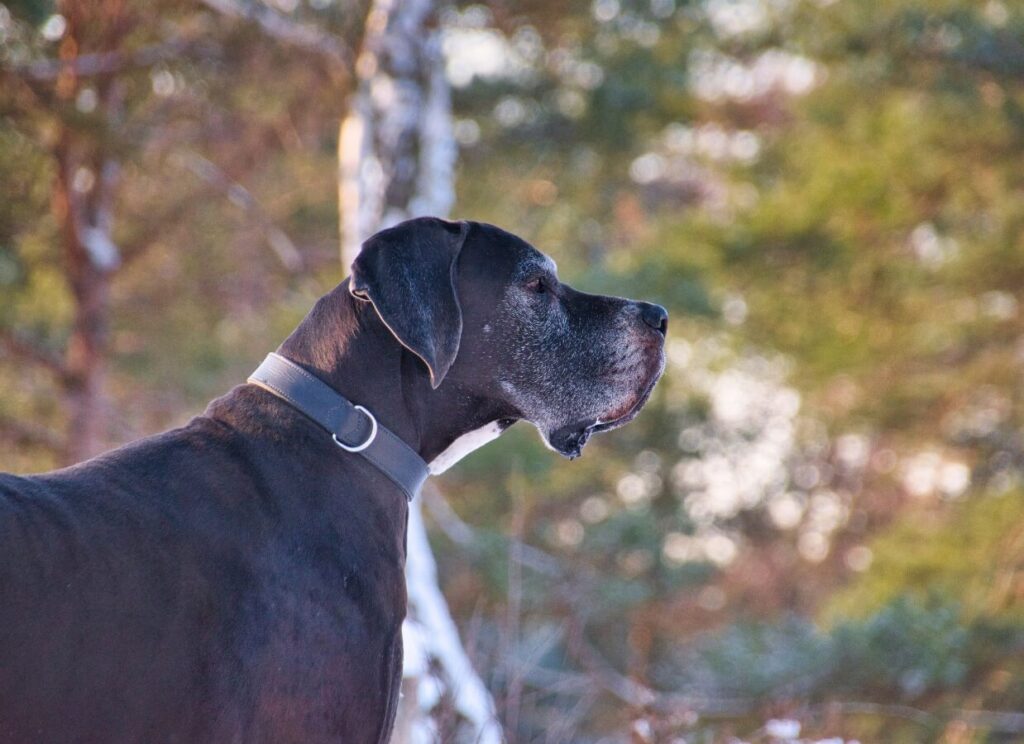
Temperament of Black Great Danes
Black Great Danes are known for their laid-back, calm temperament.
These dog’s have long been prized for their easygoing nature and even disposition, making them the go-to canine choice for families with young children.
Unlike other dog breeds, which can become easily excitable or territorial, Great Danes tend to be naturally gentle and non-confrontational.
In addition, these dogs grow to be very large in size, but they retain a very puppy-like energy level throughout their lives.
Whether frisking around the dog park with other playful pups or cuddling up at home on the couch with their favorite humans, Black Great Danes always seem to be just a tiny bit calmer than their counterparts of other colors.

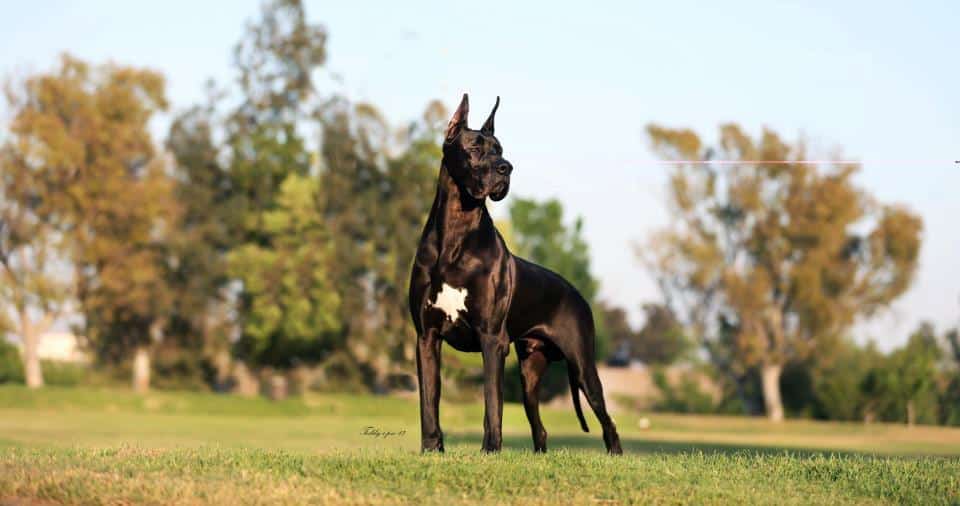

Competitive Sports and A Black Great Dane
Who says competitive sports are just for humans? Canine sports have been around for centuries and are a great way for a Black Great Dane to stay active and have fun. In the early days, canine sports were used as a way to train hunting dogs.
Today, they’re popular all over the world and there are even canine sports competitions sanctioned by the American Kennel Club.
A Black Great Dane makes a great competitor in dog sports because of their size and athleticism.
If you’re looking for a fun activity for your Black Dane, consider signing up for a dog sport class or competition. Your dog is sure to have a blast – and you might even end up taking home a trophy!
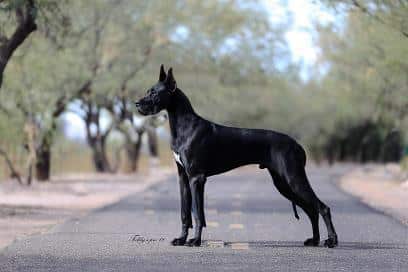
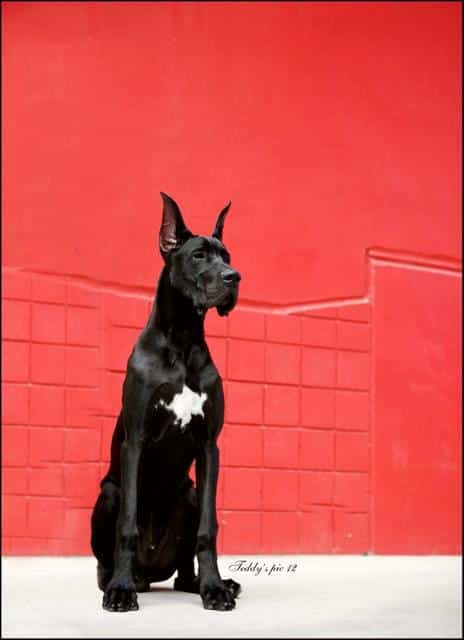
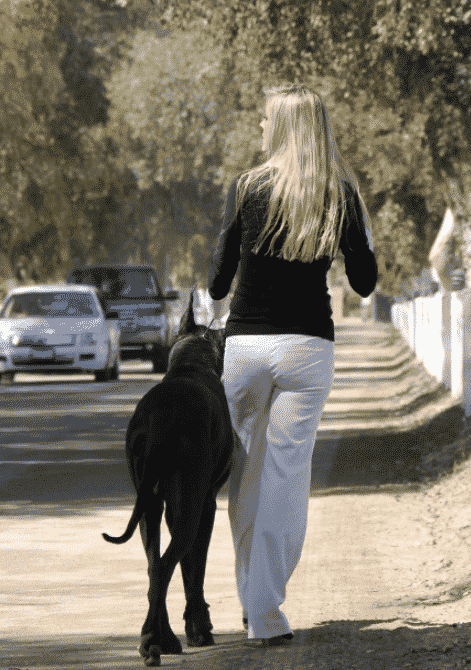
Great Dane Standard Colors
There are seven breed standard colors of Great Danes: black, blue, brindle, fawn, harlequin, mantle, and merle.
The Black Great Dane is not the most popular color, but people who see them are star-struck.
Black Great Danes
While most people are familiar with the fawn and brindle colors, Black Great Danes are actually quite rare when they are completely solid.
14 Exciting Things about Black Great Danes
Blue Great Danes
One striking color is the blue great dane, which gets its brilliant blue coloring from a special blue gene known as the “merle” gene, which can range anywhere from blue to black. For that reason, there can be ‘blue’ merle or ‘standard’ merle.
Merle Great Danes
The merle gene can also cause other patterns and markings on the dog’s coat, including harlequin, fawn, and mantle.
Harlequin Great Danes
Harlequin is a color pattern that is made up of a white coat with black patches. Sometimes, there can also be gray patches.
Mantle Great Danes
Mantle Great Danes are mostly black with white markings on the chest, neck, and legs.
Whether you favor black dogs or another color, one thing is certain – there is no denying the beauty of a Great Dane!
Breed Standard for A Black Great Dane
A glossy black coat with moderate white markings and a short, dense fleece coat are the standards for the Black Great Dane.
Black Great Danes are often noted as the ‘softest’ and ‘silkiest’ of all Danes.
One of the largest breeds, they weigh between 100 and 130 pounds as females and 130-160 as males on average. They stand 28 to 36 inches at the shoulder.
The glossy black coat is the result of selective breeding and should be free of any rust, brindle, or other colors.
Euro Danes: A Big, Droopy Problem
What Does Euro Mean in Great Danes?
The moderate white markings include a small amount of white on the chest and toes.
The short, dense fleece coat is black with a small amount of white on the chest and belly. This color in the Great Dane is recognized by the AKC.
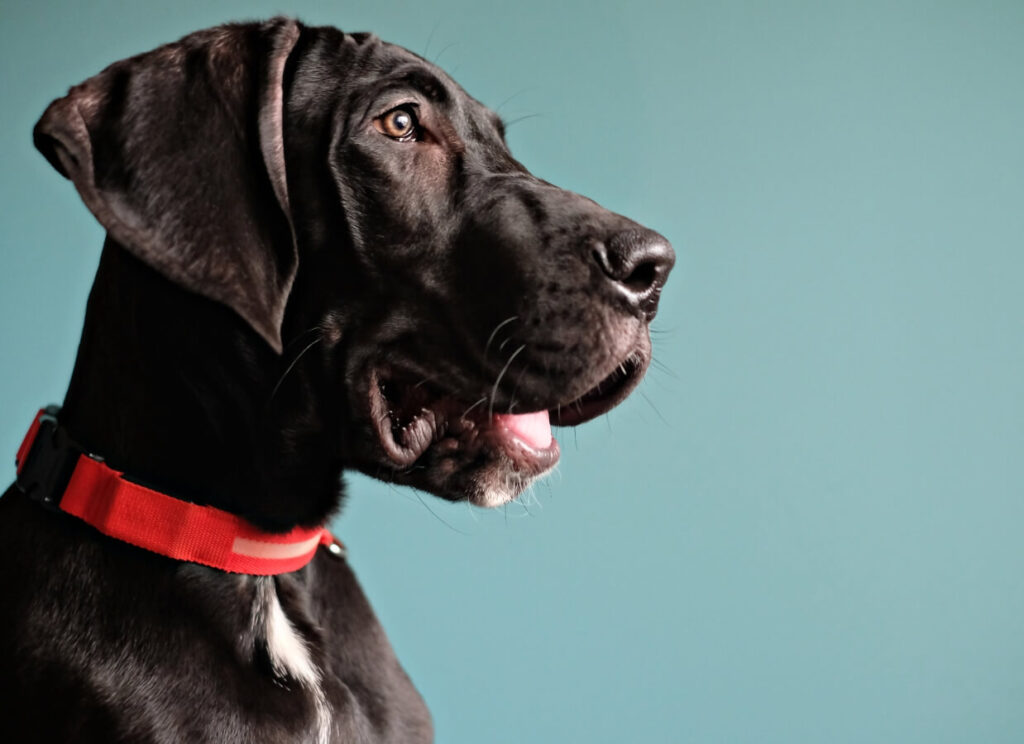
Black Great Dane and Ear Cropping
Although many people believe that cropped ears are an essential part of a Great Dane’s appearance, there are pros and cons to both sides (crop or not).
What is Ear Cropping?
Cropping a dogs ears consists of cutting off a portion of the ear and then taping them to stand erect.
Some people believe that cropping makes these breeds look more intimidating and ‘guard-like.’
What are the pros and cons of ear crops?
It is worth considering the pros as well as the downsides of this procedure for large breed dogs.
For one thing, despite controversial conversation, cropped ears do not cause any pain and discomfort for the dog. Cropping your puppies ears does require surgery to remove a portion of the ear and must be done before 8 weeks to remain ethical.
However, when done ethically by an experienced surgeon, it will be as painless as getting their dewclaws removed.
Posting Ears
On the contrary, ears that are cropped are difficult to maintain, requiring pet parents to post the ears for months after surgery in order to keep them upright.
Despite these pros and cons, cropped ears remain popular among owners of Black Great Danes due to their association with this specific breed.
Some people believe that cropping a dogs ears helps to eliminate health issues such as ear infections, but many state that has been disputed.
Health Issues for Black Danes
Black Danes can be prone to a number of health issues.
One of the most common problems is hip dysplasia, which occurs when a dog’s hip joint fails to develop properly. Arthritis is also very common.
Other common health concerns include cancer, heart conditions, and musculoskeletal disorders.
That being said, with proper care and attention, a black Great Dane can live long, healthy life.
In fact, many great Danish dogs have flourished well into their teens and beyond!
Whether it’s through regular exercise and healthy diets or regular veterinary visits and breed-specific supplements, Black Danes can thrive if we put in the effort.
Obedience Training a Black Great Dane
Training a Great Dane begins in puppyhood and continues throughout the entire life of your dog.
As a breed who were originally bred to be a boar hound (a hunting dog to herd/hunt boars), pet parents should know that their dog’s temperament very well could be energetic and NOT a couch potato.
And since they are a large breed dog, it’s important to start socialization early on as well – getting them used to different people, animals, and environments.
This will help reduce the likelihood of your Dane developing fear-based or aggressive behaviors.
We put together a socialization guide for dog owners. You can find that guide here:
Personality of a Black Great Dane
Great Danes are very gentle, and black Great Danes are no exception. These dogs are known for their even temperaments and loving nature. Black Great Danes are often referred to as the largest lap dog. Even though they are a giant dog, they love their owners and often think they are teeny.
Like all Great Danes, black Great Danes need plenty of exercise. They also require a lot of space due to their large size.
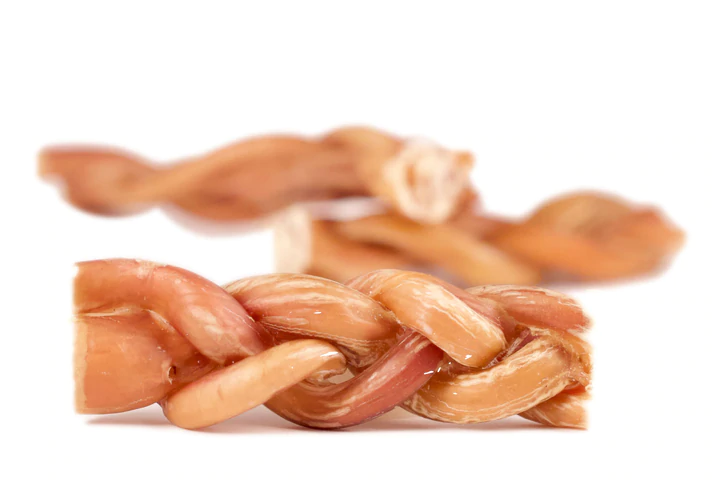

Black Great Danes are intelligent dogs and can be easy to train if you use positive reinforcement methods such as treats or praise.
Black Great Dane Puppy
If you have spent any time with any Great Dane puppies you will know that these large breeds are some of the most gentle and goofiest dogs around.
Their coal-black fur is soft and velvety, and they often have white markings on their chest and toes.
As with all dog breeds, early socialization is important for black Great Dane puppies.
This means exposing them to different people, places, sounds, and experiences in a positive way so that they grow up to be confident adults.
HOW TO FIND THE BEST CRATE FOR A GREAT DANE
Take your pup on walks around the neighborhood, introduce them to new friends, and enroll them in puppy obedience classes.
Breeding a Black Great Dane
Several different cross breeding combinations of Danes will produce black offspring.
If you are looking for a solid black Great Dane, you will want to look for Black/Black breedings. With a Black/Black breeding, you might also see Blue puppies in the litter (if the parents carry for blue).
Many black Great Danes have moderate white fur including white on their chest or toes (this is very common). These Danes often come from pairings of Harlequin and Black breeding or Mantle/Black.
Black Danes can also come from Brindle/Black or Black and fawn color combination or even Blue/Black breedings.
Pet Owner Requirements of Danes and Giant Breeds
A Black Great Dane requires much of the same things as other dogs and other Danes in regards to pet ownership.
Crates:
As large dogs, be prepared to spend quite a lot of money on them for food, treats, supplies (collars, leashes), a kennel/crate, and toys.
You might be surprised to hear that a Danes are definitely kennel dogs- most Danes LOVE to spend time in the comfort of their crate. We have compiled a list of our favorite crates for big dogs here:
Food:
A black Great Dane should be fed a high-quality diet that is formulated for large breeds.
This will help ensure that they grow at a healthy rate and don’t put too much strain on their developing joints.
Amongst a few others, we recommend this food for large breed puppies:
As Dane owners and lovers, we recommend certain foods that we have researched and know well, for the Great Dane breed, some being raw and some being kibble. Here is some of the raw food we recommend, linked for your convenience:
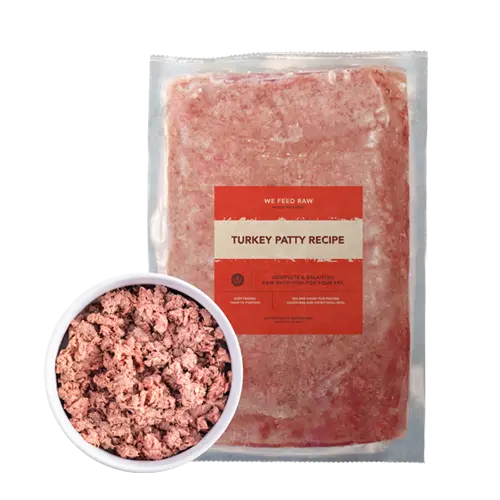
Bed
An orthopedic dog bed is one of the most important things you can buy for your dog- beginning in puppyhood. Regardless of your dog’s age, they should not be sleeping on hard surfaces with their joints touching the hard floor. As you know, big dogs are predisposed to joint disease such as arthritis and hip dysplasia.
Providing an orthopedic bed will help to eliminate the pressure on their joints that they might experience from laying on a hard surface and will encourage them to get up and move around.
Here is the orthopedic bed that we recommend:
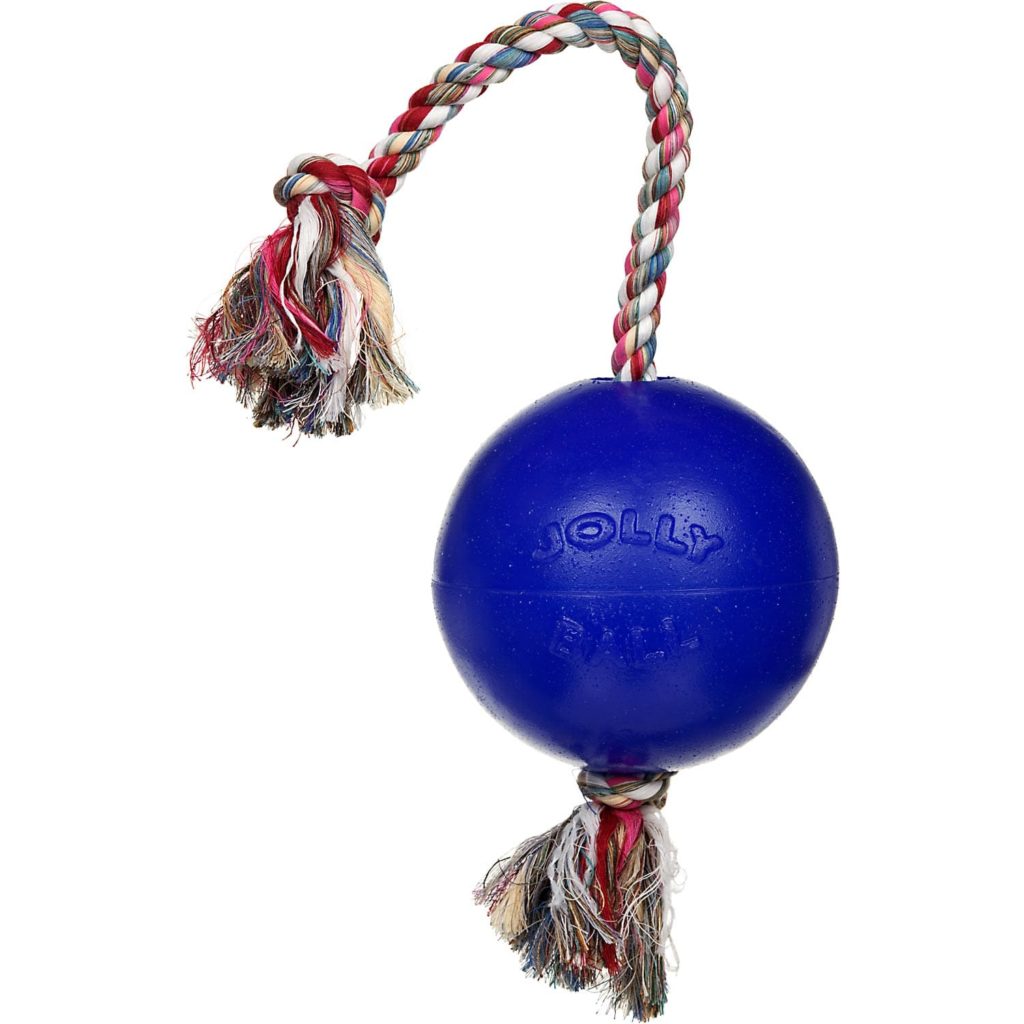
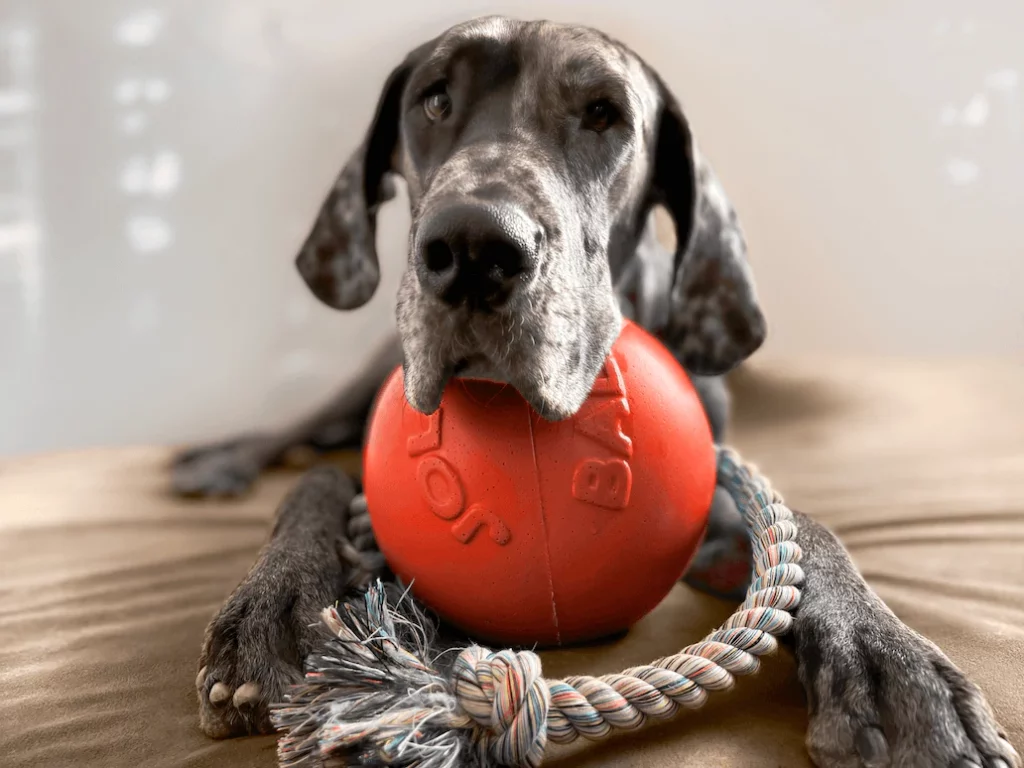
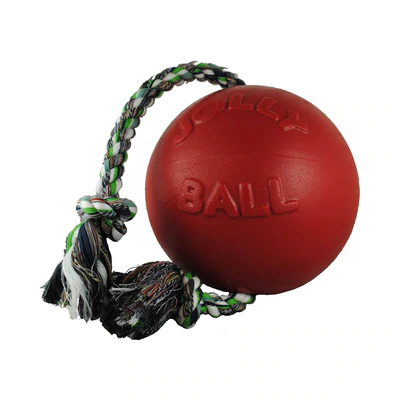
Dietary Requirements for a Black Great Dane
We have an abundance of food and diet resources here on this website for your convience. Dane parents are plagued constantly with an abundance of questions. Here are some of the most asked questions, linked to resources for you to peruse:
- Should I feed my dog grain free?
- My breeder is making me feed a food I don’t want to feed.
- Should I feed puppy food or adult food and does my Danes age make a difference?
- What is considered a high quality food for my dog?
- Is my puppy growing appropriately or should I feed it more?
The following is a standard feeding chart for growing puppies. Please keep in mind that not all puppies will grow at the same rate, nor need the same amount of food.
| Birth | 1-2 lbs |
| 1 Week | 2-3 lbs |
| 2 Weeks | 3-5 lbs |
| 3 Weeks | 4-7 lbs |
| 1 Month | 5-8 lbs |
| 6 Weeks | 10-20 lbs |
| 2 Months | 15-30 lbs |
| 3 Months | 25-45 lbs |
| 4 Months | 45-65 lbs |
| 5 Months | 60-85 lbs |
| 6 Months | 65 – 100 lbs |
| 7 Months | 70-110 lbs |
| 8 Months | 80-120 lbs |
| 9 Months | 85-125 lbs |
| 1 Year | 95-120 lbs |
| ADULT | |
| Female | 110-145lbs |
| Male | 135-170lbs |
Where to Buy a Black Great Dane?
If you are looking for a black Great Dane you are going to want to research the Great Dane club of America. The GDCA is a national breed club that provides pet parents with information regarding the breed, where to buy a Great Dane and what to look for in a quality breeder.
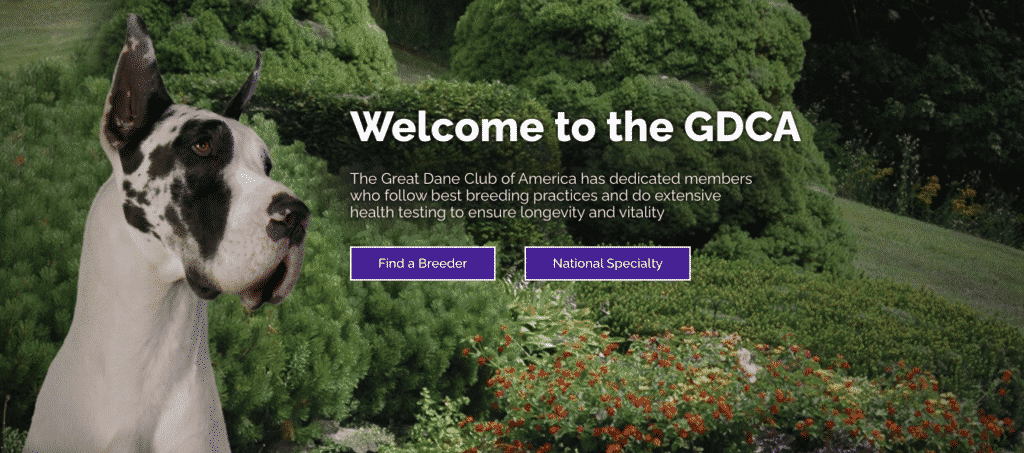
America Breeder’s Color Code
The GDCA also has a Color Code within their code of ethics. This means that the breeders will not be breeding off standard colors, or breeding two colors together that will cause harm to the puppies. (Two harlequins or two merles or one of each can cause blind and deaf puppies called Double Merle).
GREAT DANE CLUB OF AMERICA BREEDER’S CODE OF ETHICS
The GDCA actually has a code of ethics for all breeders that states the following: This Code is established in accordance with the objectives of the GDCA to protect and advance the interests of Great Danes and to provide guidelines for responsible ownership and ethical breeding practices.
ALL MEMBERS SHALL:
- Maintain the best possible standards of health, cleanliness, safety and care of their dogs.
- Breed Great Danes which are temperamentally and structurally sound.
- Refrain from further use of a Great Dane for breeding if the dog or bitch has produced any offspring with serious inherited defects.
- Not breed to an unregistered Great Dane.
- All dogs and bitches to be bred be x-rayed prior to breeding and declared free of hip dysplasia by a knowledgeable Veterinarian or the OFA. It is also encouraged that any and all technology available be used to screen all animals to be used for breeding, according to known problems within the breed (e.g. OFA, cardiac check, thyroid check, vWD, PRA, etc.).
These are just a FEW of the many requirements to be apart of the GDCA Code of Ethics. If you are looking for a Gentle Giant, you do NOT want to simply look on Facebook or Craiglist, but rather do your research and find a breeder willing to actually put in the work to help make your pup into the breed they are supposed to be.
Are Gentle Giants Worth It?
Danes are a big responsibility. They come with a lot of needs such as proper socialization, training, nutrition, exercise, and grooming. Great Danes are NOT for everyone.
But, one thing is for certain: you will fall in love with a gentle giant if you have the opportunity to have one in your life.
READ MORE:

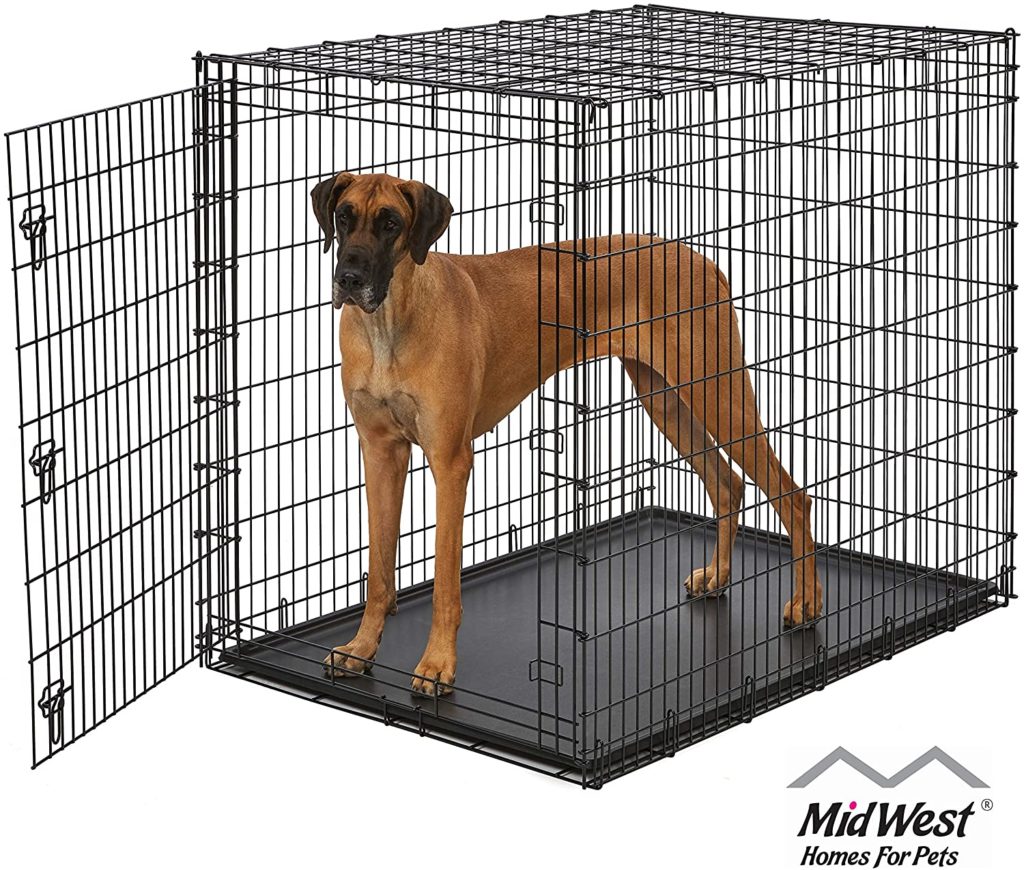
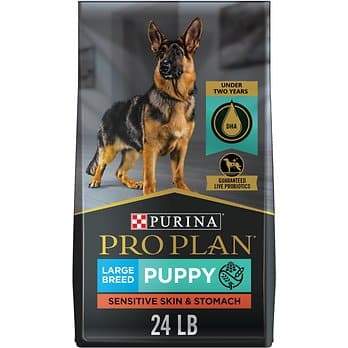
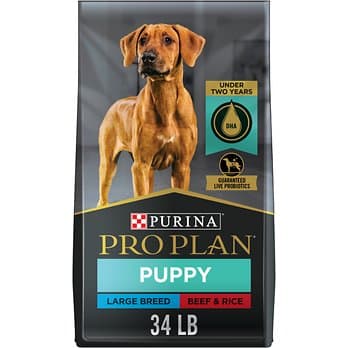
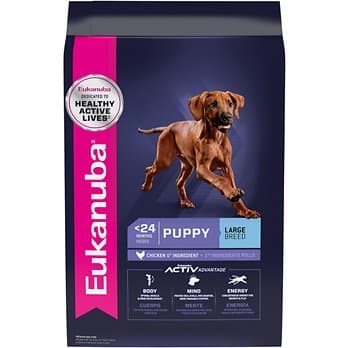
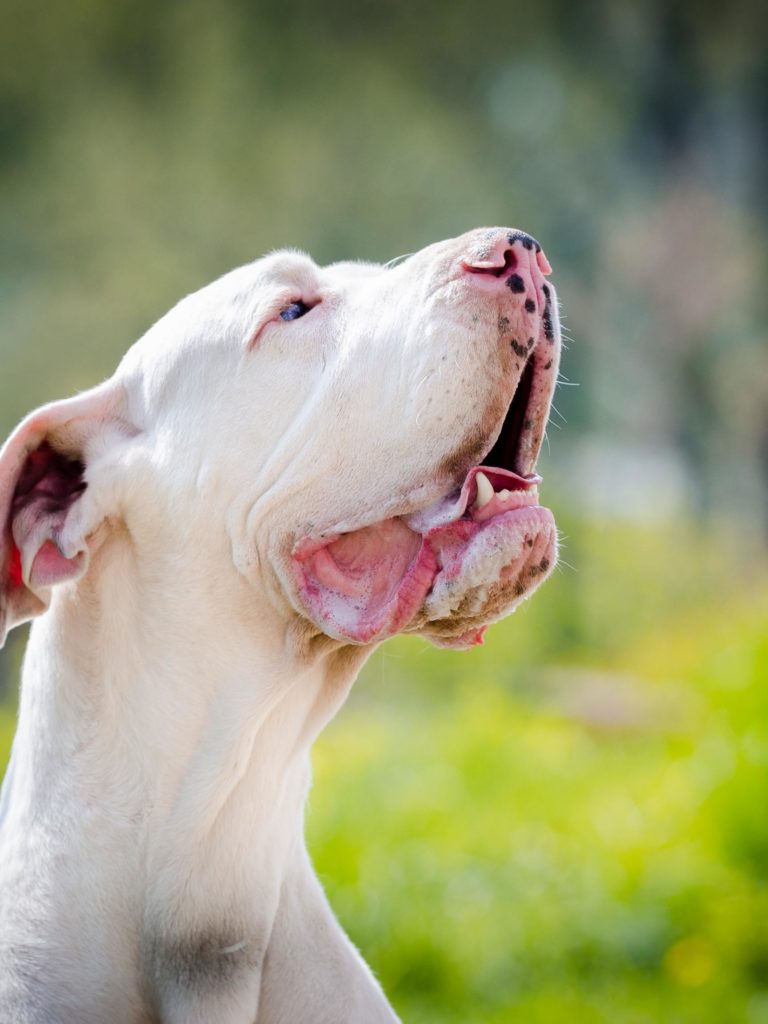
Leave a Reply